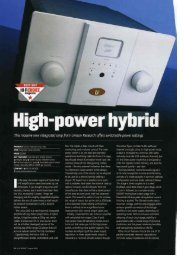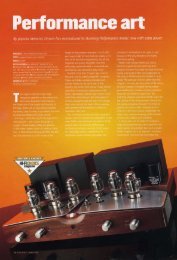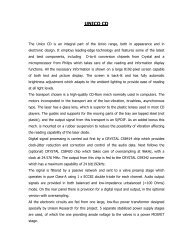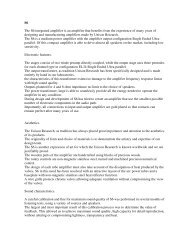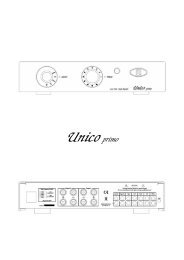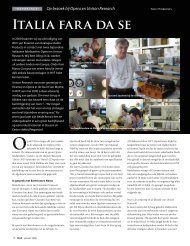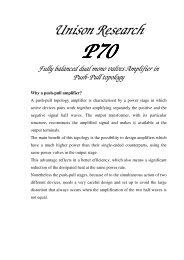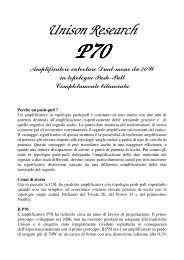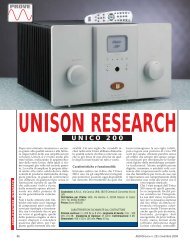CES 2013: Unison Research and the UPower Tube Booster Amplifier
CES 2013: Unison Research and the UPower Tube Booster Amplifier
CES 2013: Unison Research and the UPower Tube Booster Amplifier
Create successful ePaper yourself
Turn your PDF publications into a flip-book with our unique Google optimized e-Paper software.
Confessions of a Part-Time Audiophile<br />
ADD meets OCD in audio's high-end<br />
<strong>CES</strong> <strong>2013</strong>: <strong>Unison</strong> <strong>Research</strong> <strong>and</strong> <strong>the</strong> <strong>UPower</strong> <strong>Tube</strong> <strong>Booster</strong> <strong>Amplifier</strong><br />
Posted on January 17, <strong>2013</strong><br />
Like many audiophiles, I wish that my flea-powered amplifier wasn’t quite so … anemic … when it came to<br />
modern loudspeakers. I mean, if it wasn’t for all <strong>the</strong> crazy-low impedance swings or sub-90dB sensitivity ratings,<br />
SET amps might still be relevant. Sadly, most loudspeaker designers could give two farts about all that — <strong>and</strong> I<br />
suppose that an argument can be made that blah blah blah sound quality blah blah blah. Whatever. The upshot is<br />
that most SET amps are pretty much useless, unless you opt for some wildly compromised or terrifically<br />
marginalized product to pair <strong>the</strong>m with. Yes, yes — <strong>the</strong>re are some manufacturers that “do that” sort of thing (Zu<br />
Audio <strong>and</strong> Rethm spring to mind), but <strong>the</strong> sad fact is that <strong>the</strong> average Dynaudio, Wilson, or B&W will never<br />
sparkle with 8 watts — it’s long past time to get over it <strong>and</strong> move on, right?<br />
Follow
R-i-i-i-i-i-g-h-t.<br />
Well, not so fast. Maybe not.<br />
Enter <strong>the</strong> <strong>Unison</strong> <strong>Research</strong> Unico <strong>UPower</strong> amplifier, shown here in a ra<strong>the</strong>r unassuming black box <strong>and</strong> positioned<br />
directly below <strong>the</strong> very comely $2,495 Simply Italy integrated amplifier in a cleverly elegant stackable Splintr<br />
Designs Trellis rack ($2,000, as configured). An El34-based SET amp, <strong>the</strong> Simply Italy is “good for” 12wpc, which<br />
is plenty with just about any loudspeaker — assuming that it has a sensitivity of 95dB or higher. The very shapely<br />
(if you’re getting a vibe about <strong>the</strong> look <strong>and</strong> feel for <strong>the</strong> gear in this room, that’s not an accident) Opera Gr<strong>and</strong><br />
Mezza loudspeakers ($2,795/pair) are only 89dB. Common wisdom would tell you that this is not a match. Tone<br />
should be “just fine”, especially through <strong>the</strong> mid-b<strong>and</strong>, but turn it up <strong>and</strong> you should expect <strong>the</strong> bass to flabbify,<br />
<strong>the</strong> treble to turn glassy or hard, <strong>the</strong> imaging to collapse, <strong>and</strong> cats <strong>and</strong> dogs to suddenly opt for cohabitation (or<br />
something equally horrible, YMMV).<br />
Now, with <strong>the</strong> <strong>UPower</strong>, that changes a bit. Wire <strong>the</strong> amp into <strong>the</strong> “booster” <strong>and</strong> <strong>the</strong> booster into <strong>the</strong> loudspeakers<br />
<strong>and</strong> that 12 watts becomes 48. Ta-da! And yes, Virginia, 48 wpc should be more than enough to rock your world —<br />
with an 89dB loudspeaker.<br />
Sounds great, no? Sure! It also sounds familiar. But wait:<br />
There are already some “booster” amplifiers on <strong>the</strong> market, but <strong>the</strong>y use <strong>the</strong> amplifier with a<br />
dummy load (typically a fixed amount of resistance) to produce only an amplified voltage output.<br />
These “booster” amps are characterized by a suitable voltage gain. In this way, however, <strong>the</strong><br />
character of [<strong>the</strong>] sound due <strong>the</strong> [original] amplifier … is completely lost.<br />
The Upower does not use a dummy load. The amplifier is always loaded by <strong>the</strong> actual impedance<br />
of <strong>the</strong> speaker; <strong>the</strong> voltage <strong>and</strong> <strong>the</strong> current that <strong>the</strong> amplifier provides are both simultaneously<br />
amplified by <strong>the</strong> Upower. This [is] a true “amplifier of power,” having both voltage gain <strong>and</strong><br />
current gain well defined. The sensitivity of <strong>the</strong> amplifier to <strong>the</strong> impedance of <strong>the</strong> speaker remains<br />
unchanged as <strong>the</strong> speakers “appear” as directly connected to <strong>the</strong> amplifier output terminals, an<br />
operative condition that, as already stated above, [maintains] <strong>the</strong> character [of] <strong>the</strong> sound.<br />
Okay. I’m curious. Where’s mine? Price is $2,695 in silver, $2895 in black. A <strong>Unison</strong> <strong>Research</strong> Unico CDE player<br />
($4,120 with dual mono DAC upgrade) provided <strong>the</strong> tunes. All speaker cable, ICs <strong>and</strong> power cords came from <strong>the</strong><br />
Cardas Audio Clear Light line.<br />
Confessions of a Part-Time Audiophile<br />
Theme: Twenty Ten Blog at WordPress.com .<br />
Follow
Follow
Share this: Mi piace 47 More<br />
This entry was posted in <strong>CES</strong> <strong>2013</strong> <strong>and</strong> tagged ces, opera, simply italy, unison research. Bookmark <strong>the</strong> permalink.<br />
5 Responses to <strong>CES</strong> <strong>2013</strong>: <strong>Unison</strong> <strong>Research</strong> <strong>and</strong> <strong>the</strong> <strong>UPower</strong> <strong>Tube</strong> <strong>Booster</strong> <strong>Amplifier</strong><br />
Steven Folberg says:<br />
January 17, <strong>2013</strong> at 9:04 AM<br />
0 0 Rate This<br />
So, how did it sound?<br />
Reply<br />
Part-Time Audiophile says:<br />
January 17, <strong>2013</strong> at 9:33 AM<br />
Follow
0 0 Rate This<br />
IIRC, <strong>the</strong> room was a bit noisy, so, hard to say anything o<strong>the</strong>r than: “very nice”.<br />
Reply<br />
Alastait says:<br />
January 17, <strong>2013</strong> at 4:07 PM<br />
0 0 Rate This<br />
Didn’t Musical Fidelity do something similar a few years ago with <strong>the</strong> Supercharger. It didn’t catch on….<br />
Reply<br />
Marc Phillips says:<br />
January 17, <strong>2013</strong> at 6:38 PM<br />
0 0 Rate This<br />
The MF unit tended to change <strong>the</strong> sonic characteristics of <strong>the</strong> original amplifier to <strong>the</strong> point where you asked<br />
yourself, “Why don’t I just get a more powerful amp?” The Upower excels at preserving <strong>the</strong> sound of <strong>the</strong> original amp<br />
since it only provides a boost when needed. And I’ll tell you that a 48 wpc Simply Italy for about $5K is a beautiful<br />
thing. I’m using <strong>the</strong> Upower right now with <strong>the</strong> 27wpc <strong>Unison</strong> <strong>Research</strong> Sinfonia, giving me 108wpc of 6550-based<br />
tube sound that is much more dynamic <strong>and</strong> controlled than any 6550/KT88 amp I’ve heard.<br />
Reply<br />
Demerara says:<br />
January 18, <strong>2013</strong> at 3:32 PM<br />
0 0 Rate This<br />
The Burson PP160 (recently discontinued) has a “tube booster” feature.<br />
From 6 moons review:<br />
“The differential class A/B dual-mono stereo amplifier is unusual by providing high-level inputs. These auxiliary speaker<br />
terminals tap into <strong>the</strong> current power buffer <strong>and</strong> bypass <strong>the</strong> class A FET input. Thus connected, <strong>the</strong> PP 160 becomes a booster<br />
amplifier for low-power tube amps. Burson asserts such transparency for <strong>the</strong>ir output stage that <strong>the</strong> harmonic fingerprint of<br />
<strong>the</strong> preceding amplifier—most likely a SET but up to 25 watts of input power are permissible—will be passed unaltered yet<br />
‘turbo-charged’ to 95/180wpc into 8/4 ohms. The Nelson Pass FirstWatt F4 amplifier with current but no voltage gain<br />
proposed a similar application. The F4 could necessitate that a SET’s output be stabilized with a small load resistor. The<br />
PP160 implementation does not.<br />
Simply connect <strong>the</strong> speaker outputs of your low-power tube amp to <strong>the</strong> speaker inputs of <strong>the</strong> Burson amp, select <strong>the</strong> latter<br />
with <strong>the</strong> rear-mounted toggle switch, <strong>the</strong>n connect your speakers to <strong>the</strong> regular output terminals. As proud owner of Shigeki<br />
Yamamoto’s stupendous—<strong>and</strong> for many applications under-powered—A-09S direct-heated 300B SET, I was all set to boost<br />
its 8-watt output <strong>and</strong> put Burson’s confident claim to <strong>the</strong> test.”<br />
I have used <strong>the</strong> booster feature on my PP160 just to see if it worked <strong>and</strong> indeed it does not seem to alter <strong>the</strong> SET sound<br />
signature in any appreciable way. That said I have not used it extensively so results may differ with different SETs.<br />
Reply<br />
Follow



